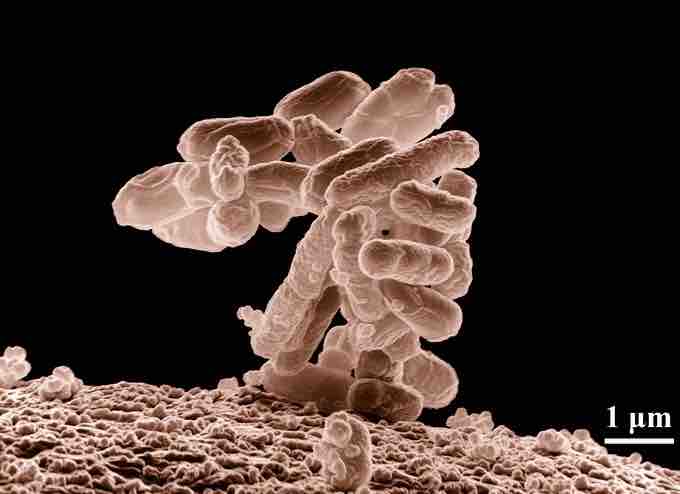An antimicrobial is a substance that kills or inhibits the growth of microorganisms such as bacteria, fungi, or protozoans . Antimicrobial drugs either kill microbes (microbiocidal) or prevent the growth of microbes (microbiostatic). Disinfectants are antimicrobial substances used on non-living objects or outside the body.

Escherichia coli
A cluster of Escherichia coli Bacteria magnified 10,000 times.
The history of antimicrobials begins with the observations of Pasteur and Joubert, who discovered that one type of bacteria could prevent the growth of another. They did not know at that time that the reason one bacterium failed to grow was that the other bacterium was producing an antibiotic. Technically, antibiotics are only those substances that are produced by one microorganism that kill, or prevent the growth, of another microorganism. Of course, in today's common usage, the term antibiotic is used to refer to almost any drug that attempts to rid your body of a bacterial infection. Antimicrobials include not just antibiotics, but synthetically formed compounds as well.
The discovery of antimicrobials like penicillin and tetracycline paved the way for better health for millions around the world. Before penicillin became a viable medical treatment in the early 1940s, no true cure for gonorrhea, strep throat, or pneumonia existed. Patients with infected wounds often had to have a wounded limb removed, or face death from infection. Now, most of these infections can be cured easily with a short course of antimicrobials.
However, with the development of antimicrobials, microorganisms have adapted and become resistant to previous antimicrobial agents. The old antimicrobial technology was based either on poisons or heavy metals, which may not have killed the microbe completely, allowing the microbe to survive, change, and become resistant to the poisons and/or heavy metals.
Antimicrobial nanotechnology is a recent addition to the fight against disease-causing organisms, replacing heavy metals and toxins, and may some day be used as a viable alternative.
Infections that are acquired during a hospital visit are called "hospital acquired infections" or nosocomial infections. Similarly, when the infectious disease is picked up in the non-hospital setting, it is considered "community acquired".
Synthetic agents include: sulphonamides, cotrimoxazole, quinolones, anti-virals, anti-fungals, anti-cancer drugs, anti-malarials, anti-tuberculosis drugs, anti-leprotics, and anti-protozoals.
Sulfonamide or sulphonamide is the basis of several groups of drugs. The original antibacterial sulfonamides (sometimes called sulfa drugs or sulpha drugs) are synthetic antimicrobial agents that contain the sulfonamide group. Some sulfonamides are also devoid of antibacterial activity, e.g., the anticonvulsant sultiame. The sulfonylureas and thiazide diuretics are newer drug groups based on the antibacterial sulfonamides.
Sulfa allergies are common, and medications containing sulfonamides are prescribed carefully. It is important to make a distinction between sulfa drugs and other sulfur-containing drugs and additives, such as sulfates and sulfites, which are chemically unrelated to the sulfonamide group and do not cause the same hypersensitivity reactions seen in the sulfonamides.
In bacteria, antibacterial sulfonamides act as competitive inhibitors of the enzyme dihydropteroate synthetase (DHPS), an enzyme involved in folate synthesis. As such, the microorganism will be "starved" of folate and die.
The sulfonamide chemical moiety is also present in other medications that are not antimicrobials, including thiazide diuretics (including hydrochlorothiazide, metolazone, and indapamide, among others), loop diuretics (including furosemide, bumetanide, and torsemide), sulfonylureas (including glipizide, glyburide, among others), and some COX-2 inhibitors (e.g., celecoxib), and acetazolamide.